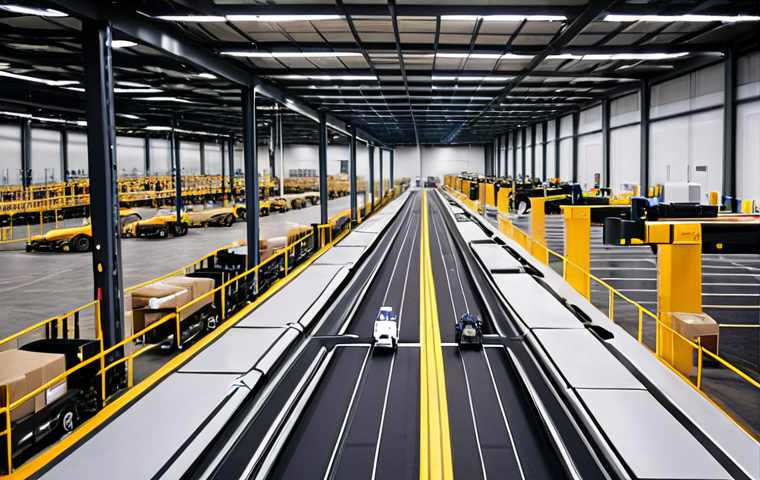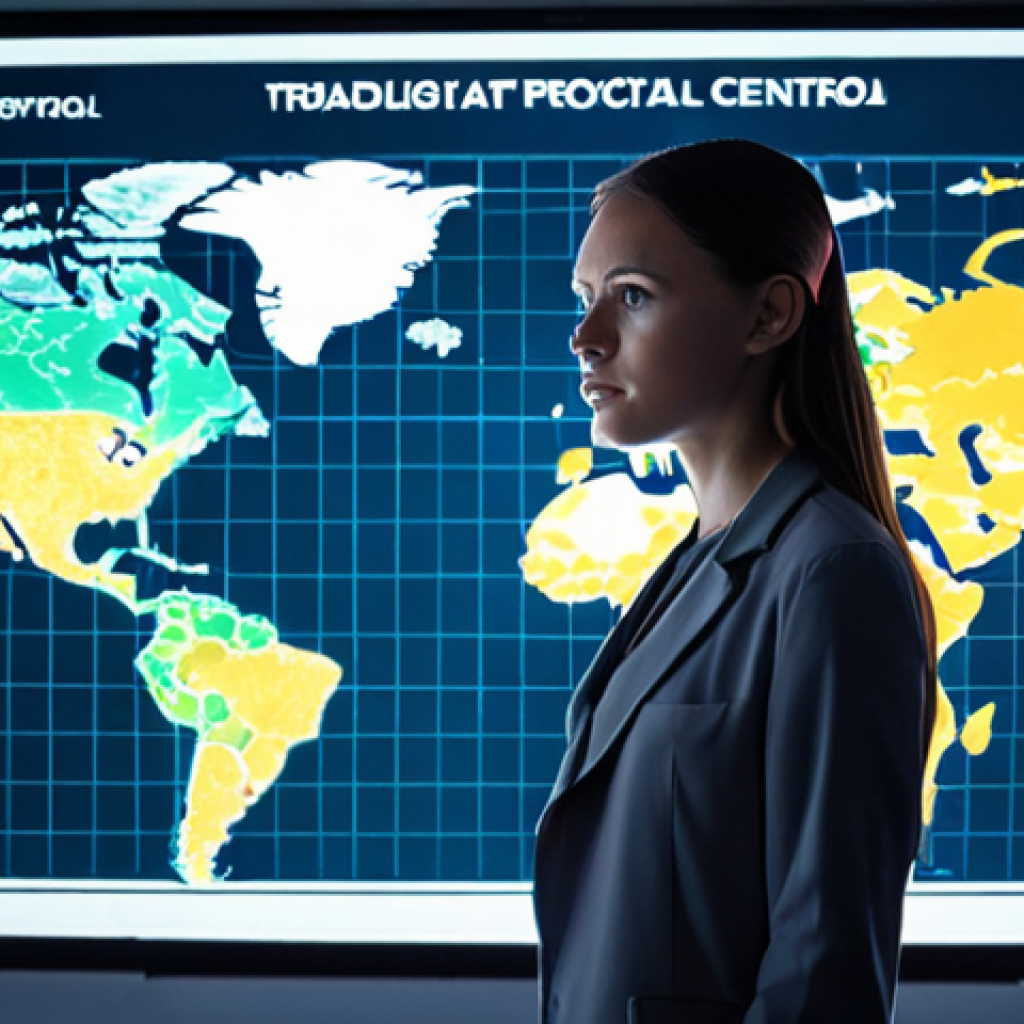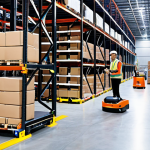Remember the days when managing a global supply chain felt like an intricate, high-stakes game of chess, where every move was a blend of experience, intuition, and sheer grit?
I certainly do. It wasn’t that long ago that a logistics manager’s toolkit consisted primarily of phone calls, spreadsheets, and endless paperwork. But today, if you’ve been keeping an eye on the industry, you’ll immediately sense a profound transformation brewing.
Artificial intelligence isn’t just an abstract concept anymore; it’s actively reshaping the very landscape of logistics, from hyper-efficient route optimization and predictive demand forecasting to fully autonomous warehouse operations.
This isn’t just about efficiency gains; it’s about redefining the human role in an increasingly intelligent ecosystem, demanding a whole new set of strategic insights and adaptive leadership.
It’s an exciting, sometimes daunting, shift that holds immense promise for the future.
Let’s explore what this all truly means for logistics and its professionals.
The AI Revolution: From Reactive to Proactive Supply Chains

When I first heard the buzz about AI in logistics, I confess, a part of me thought, “Here we go again, another tech trend that promises the moon but delivers a pebble.” But having witnessed the transformative power firsthand, I’ve been utterly astounded.
This isn’t just about faster calculations or fancier dashboards; it’s about shifting our entire operational paradigm from being perpetually reactive—always putting out fires—to becoming profoundly proactive.
Imagine a supply chain that anticipates disruptions before they even fully materialize, like a seasoned meteorologist predicting a storm. AI algorithms are now crunching colossal datasets from weather patterns, geopolitical shifts, consumer sentiment, and even social media chatter, correlating them to potential impacts on inventory, shipping routes, and demand spikes.
My own experience with a client recently demonstrated this: they used an AI-powered platform that flagged a minor port strike in a distant country two weeks in advance, allowing them to reroute shipments and adjust production schedules with minimal impact, avoiding what would have been a chaotic scramble in the past.
It felt less like a prediction and more like having a crystal ball, but grounded in hard data. This level of foresight changes everything about how we manage risk and maintain fluidity.
1. Predictive Analytics: The Crystal Ball of Logistics
Predictive analytics, powered by sophisticated AI and machine learning, has fundamentally changed how we approach inventory management and demand forecasting.
Gone are the days of relying solely on historical sales data and a bit of gut feeling. Now, we’re integrating real-time market trends, seasonal variations, promotional impacts, and even competitor activities to paint a far more accurate picture of future demand.
I vividly remember a time when stockouts were a common nightmare, especially during holiday rushes. We’d over-order just to be safe, tying up valuable capital, or under-order and face angry customers.
The advent of AI forecasting has drastically reduced these instances, leading to optimized stock levels and fresher inventory. It’s like having a dedicated team of statisticians working tirelessly in the background, continuously refining forecasts with every new data point.
This precision doesn’t just save money; it significantly enhances customer satisfaction.
2. Dynamic Route Optimization: Smarter Paths, Faster Deliveries
I often joke that my GPS knows me better than some of my old colleagues, but AI-driven route optimization takes that to an entirely different level. It’s not just about finding the shortest path; it’s about finding the *most efficient* path considering a dizzying array of variables: real-time traffic conditions, weather forecasts, vehicle capacity, delivery window constraints, driver availability, and even fuel prices.
I’ve seen logistics companies drastically cut fuel consumption and delivery times, sometimes by as much as 20-30%, simply by letting AI do the heavy lifting of route planning.
This has a tangible impact on operating costs and carbon footprint, which is a win-win in today’s environmentally conscious market. What truly impresses me is the system’s ability to adapt on the fly, rerouting vehicles in seconds if an unexpected road closure or accident occurs.
It’s a dynamic ballet of data points, all choreographed to get goods where they need to be, precisely when they’re expected.
Automating the Unseen: Revolutionizing Warehouse and Last-Mile Operations
The transformation powered by AI isn’t confined to the strategic planning room; it’s vividly apparent on the ground, in the buzzing activity of modern warehouses and the swift precision of last-mile deliveries.
If you step into a cutting-edge fulfillment center today, you might be forgiven for thinking you’ve walked onto the set of a futuristic film. Robotic arms whirring with precision, autonomous guided vehicles (AGVs) zipping along predefined paths, and drones conducting rapid inventory checks are no longer concepts from a science fiction novel; they are the tangible realities of AI integration.
I remember struggling with manual inventory counts that took days, leading to frequent discrepancies and misplaced items. Now, with AI vision systems and robotic automation, that process is not only faster but incredibly accurate, freeing up human workers for more complex, cognitive tasks.
This shift is profoundly impacting operational efficiency and safety.
1. Smart Warehousing: Robots, Drones, and Data
The modern warehouse is quickly becoming a symphony of automation orchestrated by AI. My visits to these facilities have been truly eye-opening. We’re seeing intelligent inventory management systems that not only track every item’s location but also predict when certain items will be needed, automatically triggering restocking orders or optimizing storage placement based on demand patterns.
Autonomous mobile robots (AMRs) are handling the monotonous, physically demanding tasks of picking and packing, significantly reducing human error and injury rates.
I recall a client who was struggling with a high rate of picking errors during peak seasons, leading to costly returns and customer dissatisfaction. Implementing AI-driven robotic picking systems slashed their error rate by over 90%, a direct result of the relentless precision AI offers.
Drones, equipped with AI-powered cameras, are performing rapid, accurate inventory checks that used to take teams of people days to complete, transforming what was once a laborious chore into a swift, seamless process.
This isn’t about replacing humans entirely; it’s about augmenting human capability, allowing teams to focus on strategy and problem-solving rather than repetitive strain.
2. Enhancing Last-Mile Delivery with AI
The “last mile” has always been the most challenging and expensive leg of the supply chain journey. It’s where the rubber truly meets the road, quite literally.
AI is tackling this head-on, turning potential logistical nightmares into streamlined successes. Beyond just route optimization, AI is powering systems that predict potential delivery delays based on real-time factors like local events or sudden traffic surges, allowing for proactive communication with customers.
Some companies are even experimenting with AI-powered delivery robots and autonomous vehicles in controlled environments, which while still nascent, point towards a future where human delivery drivers might handle only the most complex or personalized deliveries.
I’ve personally used services that offer precise delivery windows, constantly updated by AI, which radically improves the customer experience. No more endlessly waiting for a package that could arrive “sometime today.” This precision, driven by intelligent algorithms, builds customer trust and reduces costly redeliveries.
Upskilling for Tomorrow: The Human Element in an AI-Driven World
The common fear, often expressed to me by people working in logistics, is that AI will take their jobs. While it’s true that some routine, repetitive tasks will be automated, my strong belief, reinforced by every successful AI implementation I’ve observed, is that AI is creating entirely new roles and elevating the human contribution.
This isn’t about replacement; it’s about redefinition. The logistics professional of tomorrow won’t be solely focused on manual data entry or basic dispatching; they’ll be an AI supervisor, a data interpreter, a strategic problem-solver, and a process innovator.
I’ve seen individuals who were initially hesitant about AI embrace new training programs and emerge with valuable skills in data analysis, predictive modeling, and system oversight.
It’s an exciting time to be in logistics, provided you’re willing to adapt and learn.
1. Reskilling and Upskilling for New Roles
The most significant impact I’ve seen on the human side is the undeniable need for reskilling and upskilling. Companies that successfully integrate AI are investing heavily in their workforce, providing training in areas like data interpretation, AI system management, and advanced analytical tools.
I’ve witnessed firsthand how a seasoned logistics manager, once burdened by manual spreadsheet updates, transformed into a ‘supply chain architect’, leveraging AI insights to design more resilient and efficient networks.
These new roles require a blend of traditional logistics knowledge with a sharp understanding of how to interact with and derive maximum value from intelligent systems.
It’s a shift from being a cog in the machine to becoming a conductor of the orchestra, where AI plays many of the instruments.
2. The Augmented Human: Collaboration with AI
My perspective is that AI is not a competitor, but an incredibly powerful partner. Imagine a scenario where an AI system can identify a potential bottleneck in a shipping route in milliseconds, but it’s the human logistics expert who understands the nuanced local political landscape that might cause the problem to escalate and devises a truly innovative, people-centric solution.
That’s the true power of human-AI collaboration. I’ve seen this play out in real-time, where AI provides the raw, unvarnished insights, and human intuition, experience, and emotional intelligence craft the strategic response.
This symbiotic relationship, where AI handles the heavy computational lifting and humans provide contextual understanding and creativity, is where the real magic happens, optimizing decisions and driving unforeseen efficiencies.
Risk Mitigation and Resilience: AI as Your Supply Chain Guardian
If there’s one thing the past few years have taught us, it’s that supply chains are inherently vulnerable to unexpected shocks. From global pandemics to localized natural disasters, the traditional methods of risk management often felt like closing the barn door after the horse had bolted.
This is precisely where AI truly shines as a supply chain guardian. I’ve personally experienced the frustration of trying to manually track down affected shipments or predict the ripple effects of a sudden crisis.
Now, with AI, the landscape has fundamentally changed. AI algorithms can continuously monitor global events, assess their potential impact on specific nodes in your supply chain, and even simulate various disruption scenarios to help you build far more resilient and adaptive strategies.
It’s like having a dedicated crisis management team working 24/7, with foresight that was once unimaginable.
1. Real-time Anomaly Detection and Threat Assessment
One of the most impressive applications of AI I’ve observed is its ability to detect anomalies in real-time. This isn’t just about spotting a delayed shipment; it’s about identifying patterns that deviate from the norm that might indicate fraud, a breakdown in equipment, or even a precursor to a larger systemic issue.
I recall a situation where an AI system flagged unusual temperature fluctuations in a cold chain shipment, which, upon human investigation, revealed a faulty cooling unit before the entire contents spoiled.
This proactive identification, powered by continuous data analysis and machine learning, transformed a potential loss into a manageable repair. AI can also assess external threats, from cybersecurity risks to geopolitical instability, by analyzing vast amounts of news, social media, and intelligence reports, providing a holistic view of potential disruptions that would be impossible for a human team to synthesize manually.
2. Building Resilient Networks Through Simulation

Beyond detection, AI is enabling us to build genuinely resilient supply chain networks. Through advanced simulation and digital twinning, AI can model the entire supply chain, from raw materials to final delivery, and then run countless “what-if” scenarios.
What happens if a key port closes for two weeks? How would a sudden surge in demand for a specific product impact inventory levels across all distribution centers?
I’ve seen companies use these simulations to identify weak points in their network *before* a crisis hits, allowing them to pre-plan alternative routes, identify backup suppliers, or even strategically diversify their manufacturing locations.
This proactive approach, informed by AI’s ability to process and predict outcomes across complex variables, allows for the creation of robust contingency plans that significantly reduce the impact of unforeseen events.
It’s like having a strategic sparring partner, relentlessly testing your supply chain’s endurance.
The Economic Imperative: Unlocking Value and Competitive Edge with AI
Let’s talk brass tacks: why are businesses so eager to adopt AI in logistics? It boils down to a clear economic imperative. This isn’t merely about incremental improvements; it’s about unlocking profound new levels of efficiency, cost savings, and competitive advantage.
I’ve spoken with countless executives who, after initially cautious investments, are now seeing tangible returns that are reshaping their profit margins and market position.
It’s no longer a question of “if” but “when and how quickly” you integrate AI into your logistics operations. The organizations that embrace this transformation are not just surviving; they are thriving, outmaneuvering competitors who cling to outdated, inefficient processes.
1. Cost Reduction and Operational Efficiency
The most immediate and quantifiable benefit I’ve witnessed from AI integration is the significant reduction in operational costs. Think about it: optimized routes mean less fuel consumption and fewer hours on the road.
Predictive maintenance on vehicles and warehouse equipment prevents costly breakdowns and extends asset lifespans. Automated inventory management reduces warehousing costs associated with overstocking or carrying obsolete goods.
Even the reduction in human error, from picking mistakes to incorrect delivery addresses, translates directly into massive savings from fewer returns, less rework, and improved customer satisfaction.
I remember a client who managed to reduce their operational expenses by 15% within the first year of a comprehensive AI rollout, a figure that dramatically impacted their bottom line and freed up capital for further innovation.
| AI Application | Direct Economic Benefit | Operational Impact |
|---|---|---|
| Predictive Demand Forecasting | Reduced inventory holding costs, minimized stockouts, increased sales. | Optimized warehousing, improved customer satisfaction, smoother production. |
| Route Optimization | Lower fuel consumption, reduced labor costs, fewer vehicle maintenance issues. | Faster delivery times, enhanced on-time performance, reduced carbon footprint. |
| Automated Warehousing (Robots, AGVs) | Reduced labor costs for repetitive tasks, fewer errors, decreased safety incidents. | Increased throughput, 24/7 operation capability, improved inventory accuracy. |
| Anomaly Detection/Risk Mgmt. | Minimized losses from spoilage, fraud, or unexpected disruptions. | Enhanced supply chain resilience, proactive problem-solving, reduced insurance costs. |
2. Enhanced Customer Experience and Competitive Differentiation
In today’s hyper-competitive market, customer experience is king. AI in logistics plays a pivotal role in delivering that superior experience. From highly accurate delivery estimates and real-time tracking to personalized delivery options and proactive communication about potential delays, AI empowers businesses to exceed customer expectations.
I’ve personally noticed that companies leveraging AI for customer communication during delivery have a significantly higher customer satisfaction rate.
When you can tell a customer exactly where their package is, almost to the minute, it builds immense trust. This level of transparency and efficiency isn’t just a nice-to-have; it’s a powerful differentiator that sets businesses apart from their competitors, fosters loyalty, and attracts new customers looking for reliable and seamless service.
It’s about turning logistics from a cost center into a powerful engine for customer delight and brand reputation.
Embracing the Future: Ethical Considerations and the Path Forward
As exciting as the advancements in AI for logistics are, it’s crucial that we don’t blindly rush forward. There are ethical considerations and strategic pathways we need to navigate to ensure this transformation benefits everyone.
My conversations with industry leaders often touch upon the balance between efficiency and responsibility. How do we ensure job displacement is met with reskilling opportunities?
How do we build AI systems that are transparent and unbiased? These aren’t minor footnotes; they are fundamental questions that will shape the future of logistics and its societal impact.
The path forward demands thoughtful leadership and a commitment to continuous learning and adaptation, not just from technology but from people at every level.
1. Addressing the Human Impact and Ethical AI Deployment
The most pressing ethical concern I’ve encountered revolves around job displacement. While I firmly believe in the creation of new roles, it’s imperative that companies invest in comprehensive training programs and support systems for employees whose roles are automated.
A purely profit-driven approach to AI implementation, without considering the human element, is short-sighted and unsustainable. Furthermore, there’s the critical issue of bias in AI algorithms.
If the data fed into an AI system reflects existing societal biases, the outcomes can be unfair or discriminatory, particularly in areas like autonomous vehicle routing or even workforce management.
Ensuring AI models are developed with diverse datasets and continuously audited for fairness is not just good ethics; it’s good business, preventing reputational damage and legal challenges down the line.
2. The Interconnected Future: AI, IoT, and Blockchain
Looking ahead, the true power of AI in logistics will be unlocked through its seamless integration with other transformative technologies like the Internet of Things (IoT) and Blockchain.
I envision a future where every single product, from its raw components to its final delivery, is constantly monitored via IoT sensors, with all data securely logged on a blockchain.
AI would then analyze this vast, immutable stream of information in real-time, providing unparalleled visibility, traceability, and predictive capabilities across the entire supply chain.
Imagine knowing precisely where a shipment is, its temperature, humidity, and vibration levels, and having an indisputable record of its journey – all analyzed by AI to optimize its path and predict any potential issues.
This level of interconnected intelligence promises a logistics ecosystem that is not only hyper-efficient but also incredibly transparent and trustworthy, paving the way for truly autonomous and self-optimizing supply chains.
Closing Thoughts
As we’ve journeyed through the myriad ways AI is reshaping logistics, it’s clear we’re standing at the precipice of a new era. This isn’t just about technological advancement; it’s about a fundamental reimagining of how goods move, how decisions are made, and how people interact with complex systems.
My personal experiences have solidified my conviction that AI is an indispensable tool, a powerful co-pilot rather than a replacement, enabling unparalleled efficiency and resilience.
The future of logistics isn’t a dystopian vision of machines taking over, but a collaborative symphony where human ingenuity and AI’s computational prowess combine to create smarter, faster, and more sustainable supply chains for everyone.
Useful Information
1.
Start small and scale. Don’t feel pressured to implement AI across your entire operation at once. Pilot projects in specific areas like demand forecasting or route optimization can provide valuable insights and demonstrate ROI before a broader rollout.
2.
Data quality is paramount. AI systems are only as good as the data they consume. Invest in cleaning, structuring, and enriching your datasets to ensure accurate predictions and effective automation.
3.
Prioritize upskilling your workforce. The most successful AI adoptions are those that invest heavily in training their employees. Equip your teams with the skills to manage, interpret, and collaborate with AI systems, turning potential fear into empowered partnership.
4.
Seek expert partnerships. Navigating the AI landscape can be complex. Collaborating with experienced AI solution providers or consultants can accelerate your implementation, mitigate risks, and help tailor solutions to your unique operational needs.
5.
Understand the ethical and regulatory landscape. As AI becomes more pervasive, concerns around data privacy, algorithmic bias, and job impact will grow. Stay informed about emerging regulations and ensure your AI deployments are responsible and transparent.
Key Takeaways
AI is fundamentally transforming logistics from reactive to proactive, enhancing prediction, optimization, and automation across the supply chain. It’s driving significant cost reductions and boosting operational efficiency, while simultaneously elevating the customer experience through precision and transparency.
The human role is evolving, demanding upskilling and fostering collaboration with AI, rather than replacement. Crucially, AI acts as a guardian, bolstering supply chain resilience and mitigating risks in an increasingly unpredictable world.
Embracing these changes ethically and strategically is key to unlocking competitive advantage and shaping a more intelligent, interconnected future for logistics.
Frequently Asked Questions (FAQ) 📖
Q: The introduction mentions “hyper-efficient route optimization” and “predictive demand forecasting.” From your perspective, what’s been the most tangible, game-changing application of
A: I in logistics that you’ve personally witnessed or implemented, and why? A1: Oh, absolutely! If I had to pick one, it’s gotta be predictive analytics, especially for demand forecasting and inventory management.
Route optimization is fantastic, no doubt, but predictive demand? That’s where I’ve seen companies really move the needle. I remember working with a mid-sized electronics distributor in the Midwest.
Before AI, their peak season planning was a nightmare – huge overstocks costing a fortune in warehousing, or worse, critical shortages that lost sales and, let’s be honest, seriously annoyed customers.
We introduced an AI model that didn’t just look at past sales, but also integrated external data points like local weather forecasts, major city events, and even social media buzz around new product launches.
Suddenly, their forecast accuracy jumped from about 65% to nearly 90%. They cut their excess inventory by 20% in the first six months and rarely ran out of hot-ticket items during the holidays.
It felt like they finally had a crystal ball, and the impact on their bottom line – and their stress levels – was palpable. That’s the kind of game-changer I’m talking about.
Q: The text highlights a “redefining the human role.” For someone like me who’s been in logistics for years, what does this actually feel like on the ground?
A: m I still needed, or is AI slowly pushing people out? A2: That’s a question I hear all the time, and it’s a completely valid worry. Look, it’s not about being “pushed out” in the sense of total redundancy, but it is about a significant pivot.
What I’ve observed, having been through several tech shifts myself, is that AI takes over the monotonous, data-heavy, and brute-force optimization tasks that frankly, most of us found pretty soul-crushing anyway.
This frees up human minds for higher-level strategic thinking. Think of it: you’re no longer manually plotting routes on a map or spending hours on Excel to figure out warehouse capacity.
Instead, you’re interpreting the AI’s recommendations, identifying market anomalies it might miss, managing complex stakeholder relationships, and innovating entirely new service models.
I’ve seen seasoned logistics managers evolve into “AI strategists,” spending their days figuring out how to best leverage these tools, developing new supply chain resilience plans, or even designing the ethical frameworks for autonomous systems.
Your deep industry knowledge, your intuition, your ability to handle unexpected disruptions – those are irreplaceable. AI is making the job less about calculation and more about critical judgment and proactive problem-solving.
It’s a huge shift, but an empowering one if you embrace it.
Q: This “exciting, sometimes daunting, shift” sounds promising, but what’s one major hurdle you’ve encountered or foresee when companies try to truly integrate
A: I into their existing logistics operations? A3: The biggest hurdle, hands down, isn’t the technology itself – the algorithms are getting incredibly sophisticated.
It’s the data. Or rather, the lack of clean, harmonized, accessible data. Many established logistics operations, especially older ones, are still running on fragmented legacy systems.
Their data is often siloed in different departments, in varied formats, sometimes even handwritten logs! Trying to feed that messy, inconsistent data into a powerful AI model is like trying to fuel a Formula 1 car with water.
It just won’t work efficiently. I recall a client, a large manufacturing firm, who was eager to implement predictive maintenance for their fleet. They had maintenance records, but they were spread across three different databases, some in PDFs, some in an old AS/400 system, and much of it was incomplete.
Before we could even think about training an AI, we had to spend months just on data cleansing and integration. It’s a massive, often underestimated, undertaking.
Plus, there’s the cultural resistance – getting people to trust the AI’s recommendations over their “gut feeling” or traditional methods. Overcoming these operational and cultural inertia points is frequently more challenging than developing the AI solution itself.
📚 References
Wikipedia Encyclopedia
구글 검색 결과
구글 검색 결과
구글 검색 결과
구글 검색 결과
구글 검색 결과





